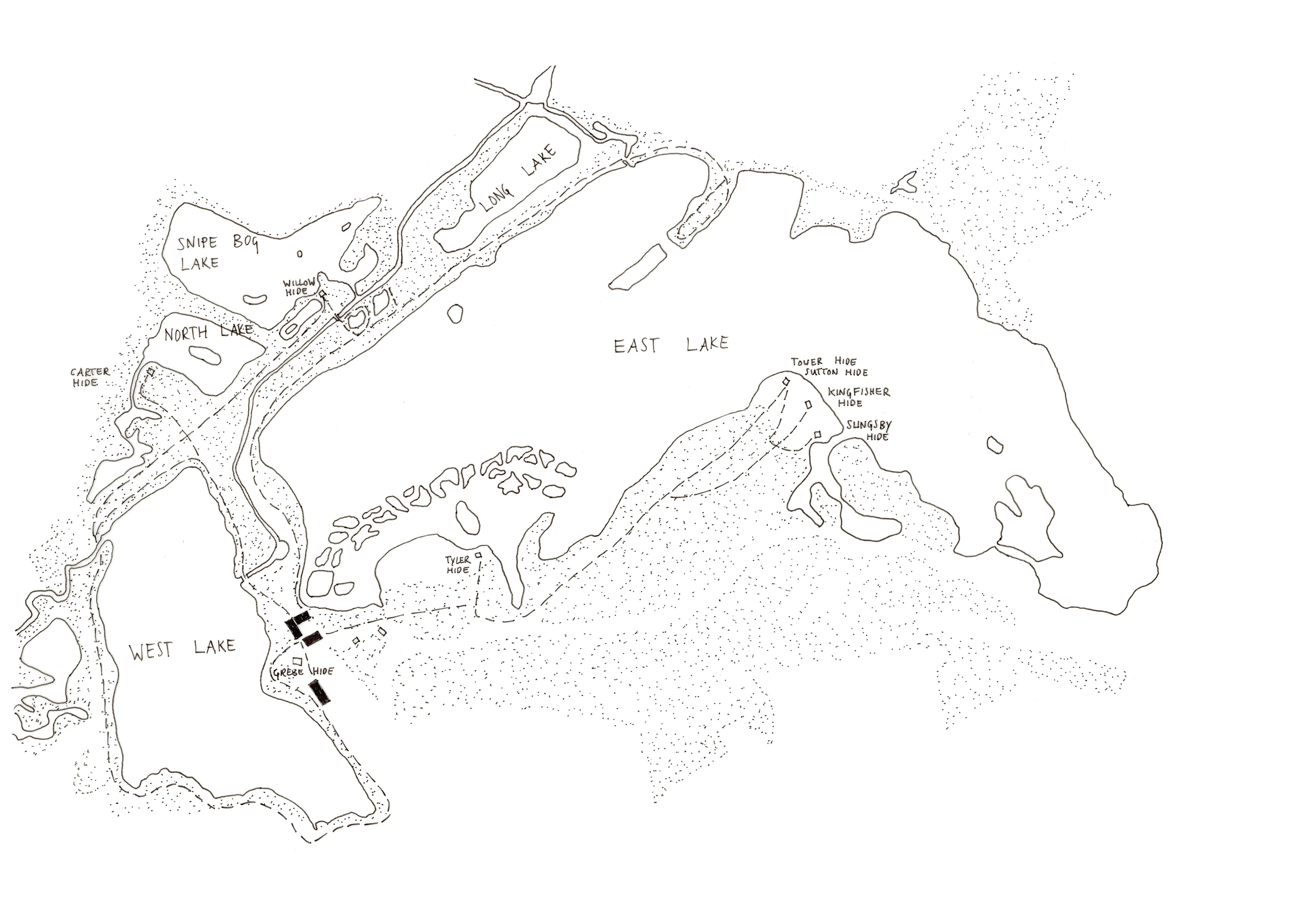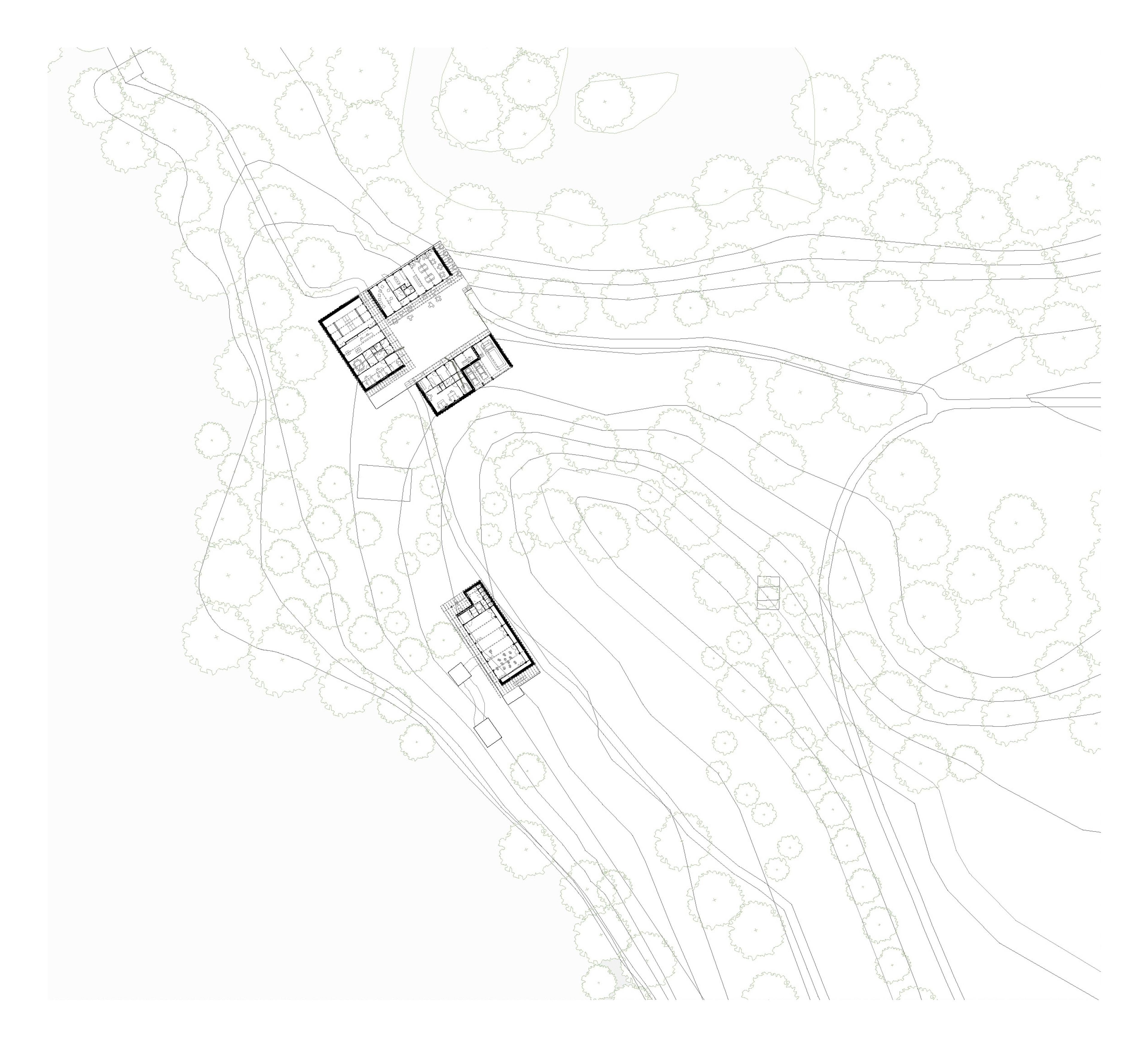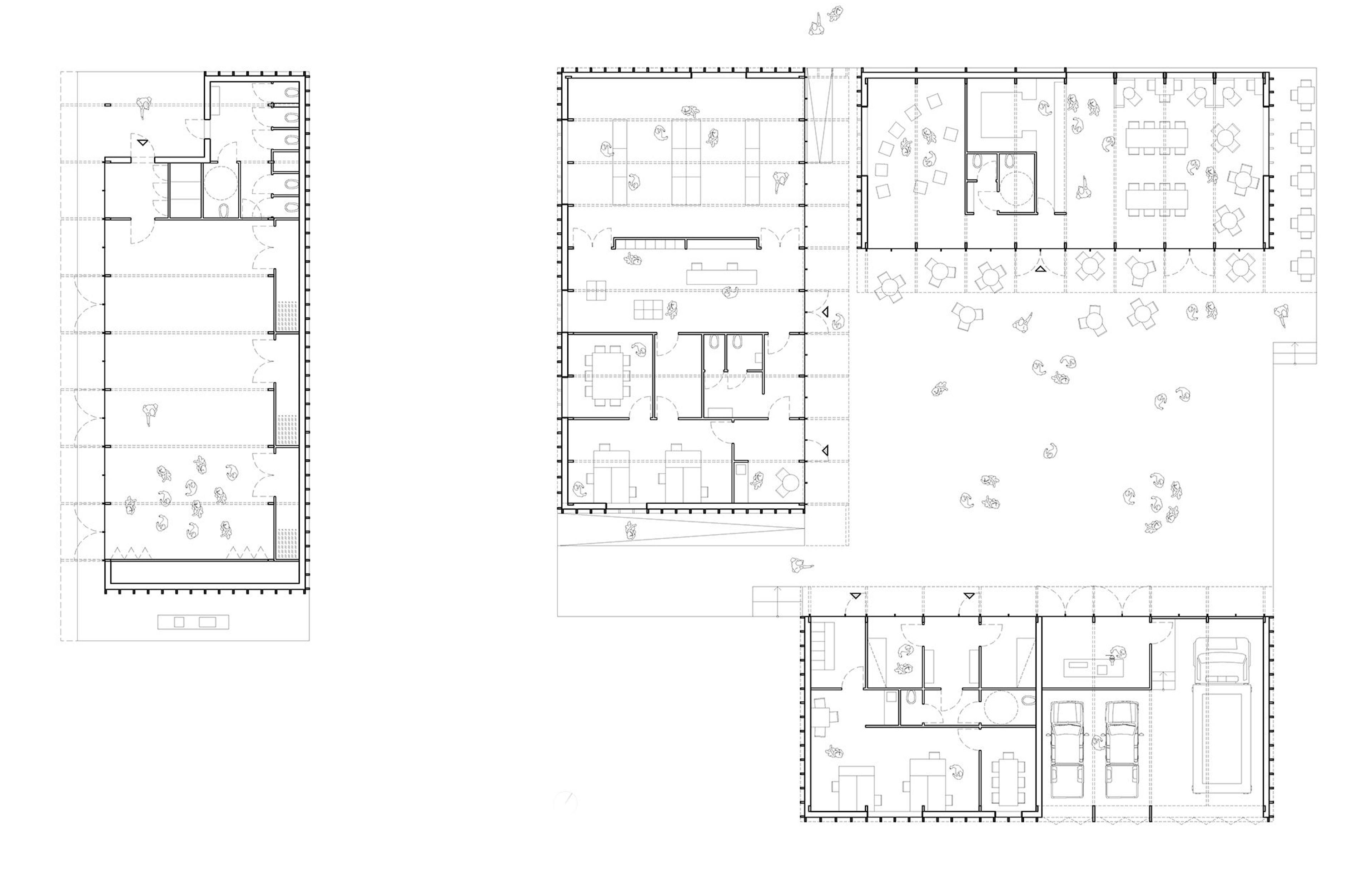Sevenoaks Visitors’ Centre

Context plan
Sevenoaks Wildlife Reserve was the first example of a gravel pit site being developed for the purpose of nature conservation. The nature reserve covers 73 hectares and comprises five lakes surrounded by mature woodland.

Site plan
The new visitors’ centre is conceived as a collection of independent single-storey buildings, modest in scale and simple in form so as not to compete with their natural surroundings.
The visitors’ centre comprises four buildings, each enjoying different views of the lakes and surrounding landscape. The studio building is sited on the footprint of the existing visitors’ centre overlooking the West Lake, while the main building, the cafe and facilities buildings are organised around an elevated courtyard on a shared plinth overlooking the East Lake.

Ground floor plans
The buildings are arranged to create a sequence of external spaces that guide the visitor naturally from their point of arrival, through an entrance at an open corner between two buildings, and up to an elevated courtyard – an external room and focal point at the heart of the visitors’ centre – from which paths lead out to all corners of the nature reserve.

View of approach to central courtyard
All buildings are closely-related in form, materials and detailing including monopitch roofs with deep over-sailing eaves that create external covered areas, open to the landscape but protected from the elements. The image of the buildings and their detailing is ambiguous: at once referencing the site’s industrial past while also consistent with the modern vernacular of rural agricultural buildings. The material of the shared plinth is washed concrete and gravel also in reference to the site’s origins.

A covered passage leading to the central courtyard
2017
Hospitality
New build
Competition
708 m²
Sevenoaks Wildlife Reserve
Nick Hill Architects & Unknown Architects
Max Fordham
Brendan Hennessy Associates
The competition entry was a collaboration with Daan Vulkers and Keimpke Zigterman of Dutch practice Unknown Architects.
Sevenoaks Wildlife Reserve was the first example of a gravel pit site being developed for the purpose of nature conservation. The nature reserve covers 73 hectares and comprises five lakes surrounded by mature woodland.
The new visitors’ centre is conceived as a collection of independent single-storey buildings, modest in scale and simple in form so as not to compete with their natural surroundings.
The visitors’ centre comprises four buildings, each enjoying different views of the lakes and surrounding landscape. The studio building is sited on the footprint of the existing visitors’ centre overlooking the West Lake, while the main building, the cafe and facilities buildings are organised around an elevated courtyard on a shared plinth overlooking the East Lake.
The buildings are arranged to create a sequence of external spaces that guide the visitor naturally from their point of arrival, through an entrance at an open corner between two buildings, and up to an elevated courtyard – an external room and focal point at the heart of the visitors’ centre – from which paths lead out to all corners of the nature reserve.
All buildings are closely-related in form, materials and detailing including monopitch roofs with deep over-sailing eaves that create external covered areas, open to the landscape but protected from the elements. The image of the buildings and their detailing is ambiguous: at once referencing the site’s industrial past while also consistent with the modern vernacular of rural agricultural buildings. The material of the shared plinth is washed concrete and gravel also in reference to the site’s origins.

Nick Hill Architects is an RIBA chartered architectural practice and design studio based in London founded in 2017.
Through a series of early built projects the practice has established a particular sensibility for the characterful use of materials; how they are combined and the care with which they are detailed – whether objects, room interiors, individual buildings or the public spaces in between.
Our design is led by thinking about how people experience objects, buildings or places. Charles Eames said the role of a designer is like that of a thoughtful host who always anticipates the needs of their guests. We hold this to be true not just for the practical or everyday, but for the poetic, the delightful, or what Louis Kahn called the ‘unmeasurable’.
At a time of climate crisis and rapid demographic change, we find ourselves designing for a future that is increasingly uncertain. In response we are committed to finding ways of making and repairing that are both resilient and adaptable, with an economy of means as a central tenet in all projects, no matter the size or budget.
Nick has twenty five years’ experience working in architectural practices in the UK and in Hong Kong.
For more than ten years he was an Associate Director at David Chipperfield’s office in London, leading a series of high profile projects including two acclaimed new public galleries, the Hepworth Wakefield in West Yorkshire and Turner Contemporary in Margate, as well as the rebuild and refurbishment of Hotel Café Royal on Regent Street, and the realisation of a masterplan for the Royal Academy of Arts campus on Piccadilly.
From 2017 he worked as a consultant to Witherford Watson Mann Architects, drawing on his experience working with public galleries and historic buildings, he led their major refurbishment of The Courtauld Gallery in Somerset House until its completion in 2021. The project was shortlisted for the RIBA Stirling Prize 2023.
Nick has been an invited critic and guest lecturer at architecture schools across the UK and in 2013 and 2014 was a guest lecturer at the Graduate School of Design in Harvard. He has served on competition juries and in 2013 was chair of the RIBA Awards jury for the East England region. He is currently an examiner for Part 3 professional studies at the Architectural Association School of Architecture.
- Kam Bava
- Neil Ditte
- Joseph Elbourn
- Anna Molodij
- Louise Trodden
- Andy Wakefield
A selection of reference images which inspire the practice’s work.
We welcome speculative applications sent as hard copy CVs with examples of work by post, or by email to info@nickhillarchitects.com (maximum 10mb).
We are currently recruiting for the role of part-time Part 2 architectural assistant. For further details refer to News section above.
Nick Hill Architects
Market 133a Rye Lane
London
SE15 4BQ
info@nickhillarchitects.com
+44 78 2446 3889
Instagram
We welcome speculative applications sent as hard copy CVs with examples of work by post, or by email to info@nickhillarchitects.com (maximum 10mb).
We are currently recruiting for the role of part-time Part 2 architectural assistant. For further details refer to News section above.